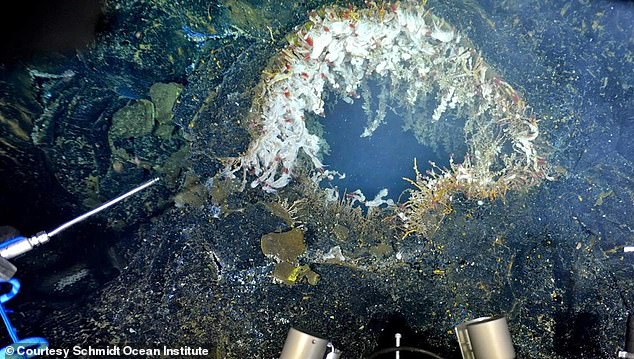Scientists monitoring a massive volcano off the California coast have warned that an eruption is just months away.
Axial Seamount, the most active volcano in the Pacific Northwest, sits just 300 miles off the US coastline and nearly a mile below the ocean’s surface.
It last erupted in 2015, but scientists have recently detected a surge in seismic activity at the site, with over 2,000 earthquakes recorded in a single day this summer.
Since then, hundreds of earthquakes have continued to shake the region daily, and the seafloor has inflated to a level similar to the 2015 eruption.
Oregon State University geophysicist William Chadwick said: ‘At the rate of inflation it’s going, I expect it to erupt by the end of the year.’
Seismic activity is a sign that magma is moving up through cracks in the volcano.
As magma rises, it inflates the chamber like a balloon, stressing the surrounding rock and triggering swarms of tiny earthquakes.
While Chadwick and other researchers were able to predict the last eruption months prior, the scientists warned that volcanoes can still surprise people and erupt without warning, making the latest earthquake swarms a clear warning sign.

Scientist William Chadwick believes the Axial Seamount (picture) is likely to erupt before the end of 2025

Recent seismic scans by the University of Washington have detected hundreds of small earthquakes around the underwater volcano
‘We had a spike of over 2,000 earthquakes in one day back in June, but since then the number of earthquakes per day has been averaging only around 100 per day,’ Chadwick and Scott Nooner from the University of North Carolina at Wilmington revealed in a recent blog post.
‘Nothing seems imminent at the moment since the rate of unrest keeps wavering up and down, up and down,’ the scientists added.
‘Of course, we don’t really know what it will take to trigger the next eruption and exactly when that will happen.’
The quakes are small, typically magnitude 1 or 2, and too far offshore for humans to feel, but they remain frequent.
When Axial Seamount does erupt, the number of underwater quakes is expected to skyrocket, rising from a hundred per day right now to as many as 10,000 earthquakes within 24 hours, according to Interesting Engineering.
When the volcano erupted a decade ago, lava came pouring out, creating 450-foot-thick lava flows.
It also formed massive structures known as pillow lavas, bulbous tubes of molten rock that solidify quickly in seawater.
‘Mt. St. Helens, Mt. Rainier, Mt. Hood, Crater Lake — those kind of volcanoes have a lot more gas and are more explosive in general. The magma is more viscous,’ Chadwick explained to the Los Angeles Times.

The Axial Seamount sits just 300 miles off the US West Coast, but an eruption is unlikely to affect people on shore

An eruption will produce large pillow lavas, tubes of molten rock that solidify quickly in seawater
‘Axial is more like the volcanoes in Hawaii and Iceland … less gas, the lava is very fluid, so the gas can get out without exploding,’ he continued.
This time, there’s also the possibility that lava could erupt from a dike, a crack that pushes magma sideways through the Earth’s crust rather than directly out of the seafloor.
Emilie Hooft, a geophysicist at the University of Oregon, said: ‘If that happens, the magma could travel laterally and erupt somewhere unexpected.’
Luckily, the eruption won’t pose any threat to human life along the West Coast, experts say.
It’s too deep and too far from shore for people to even notice when it erupts, and it has no impact on seismic activity on land.
Still, Chadwick said this next event appears to be imminent. He and Nooner were able to forecast the last eruption seven months ahead of time.
‘For a lot of volcanoes around the world, they sit around and are dormant for long periods, and then suddenly they get active. But this one is pretty active all the time, at least in the time we’ve been studying it,’ Chadwick said. ‘If it’s not erupting, it’s getting ready for the next one.’

The Axial Seamount (pictured) last erupted in 2015, and recent activity points to another event coming in the next few months
Chadwick last visited the volcano in 2024 and is scheduled to take a new expedition there in the summer of 2026.
Scientists have already installed an array of ultra-sensitive sensors, including underwater seismometers and GPS stations, to monitor every shake and swell beneath the waves.
The forecasting knowledge they’ve gained from studying the Axial Seamount could help them predict eruptions from nearby volcanoes that pose a risk to people.
One of those is Washington State’s Mount Rainier, which sits just 240 miles from the Axial Seamount.
Mount Rainier has been one of the most active volcanoes in the Pacific Northwest’s Cascade Range, and a devastating eruption remains a real possibility soon.
This article was originally published by a www.dailymail.co.uk . Read the Original article here. .

